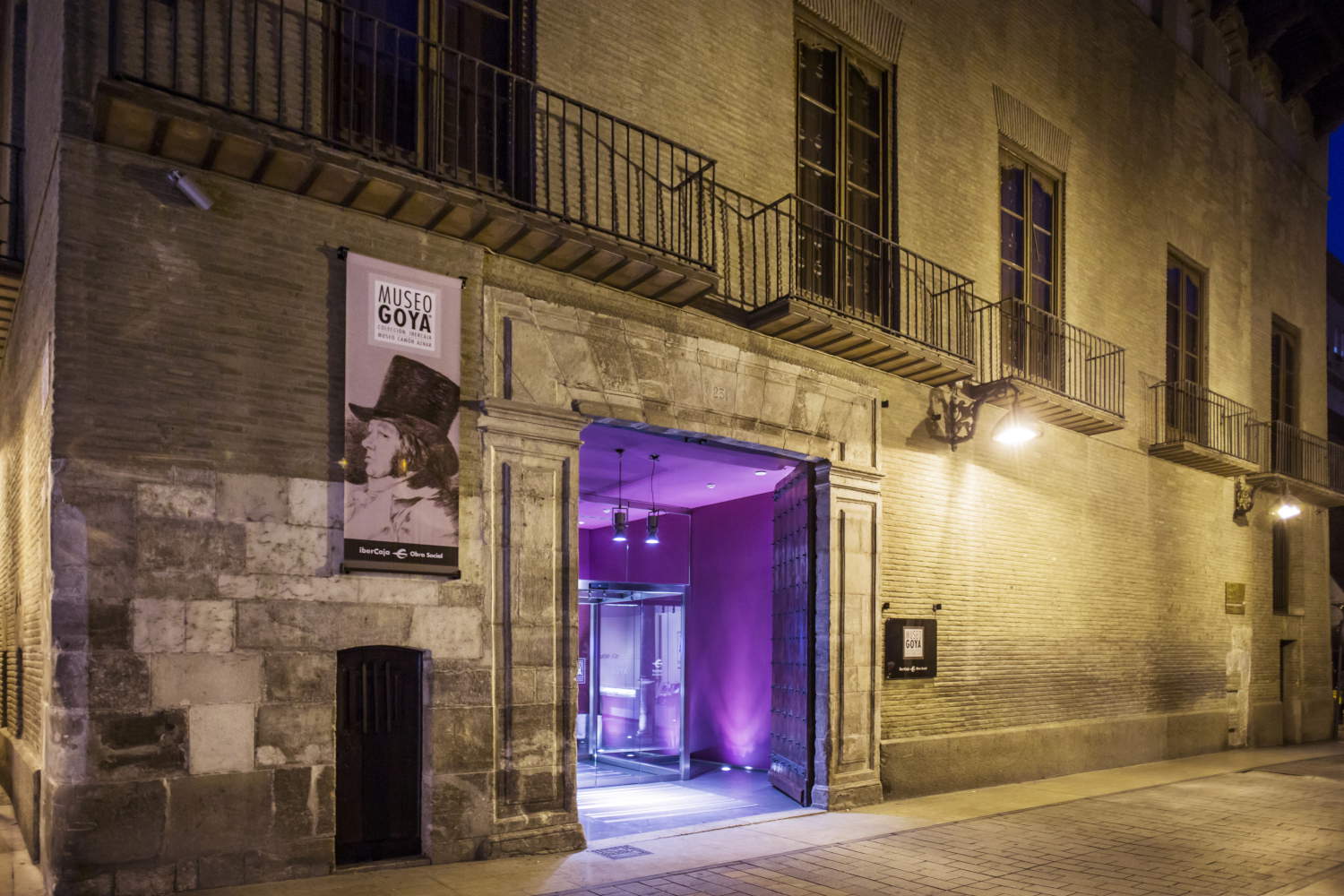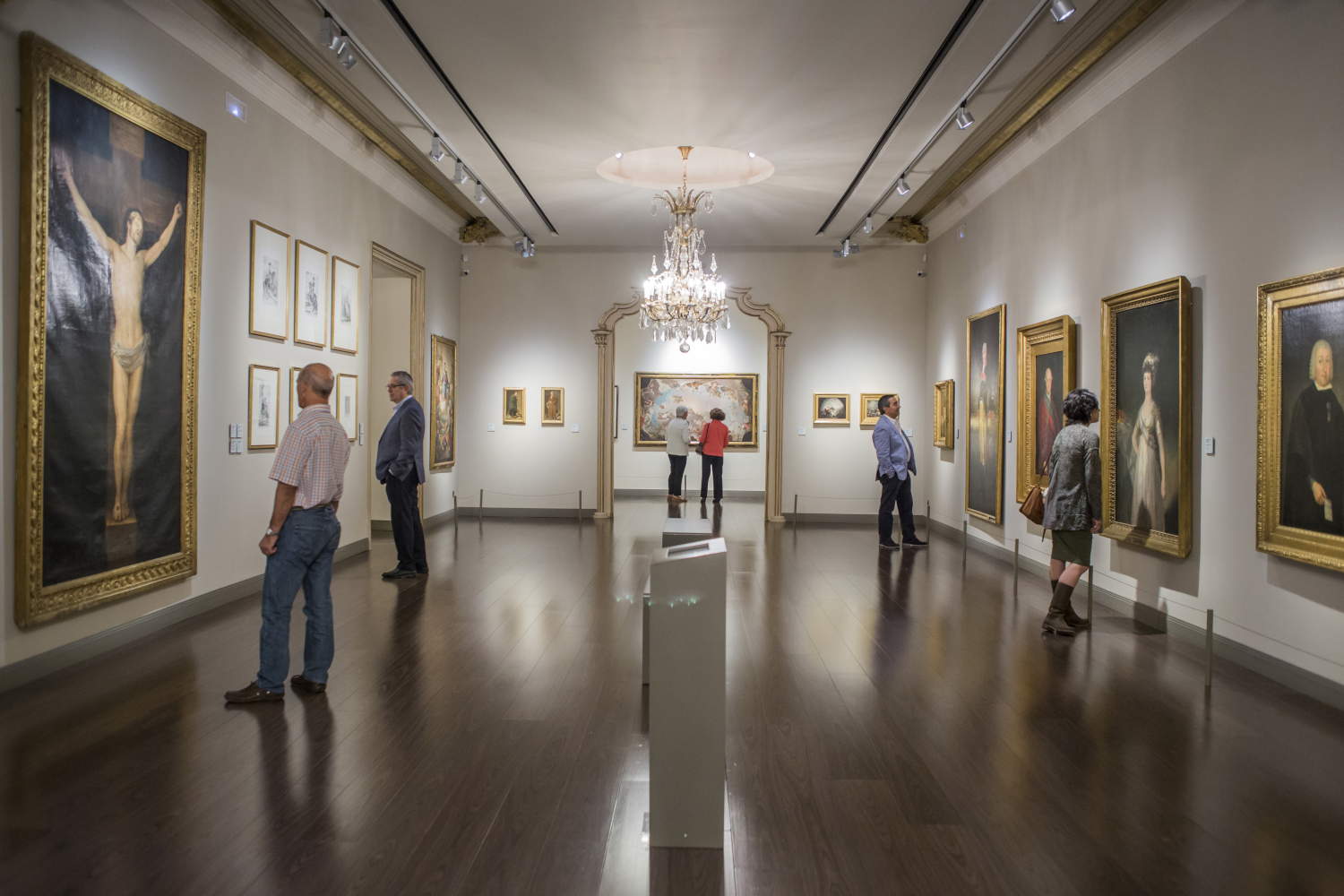The largest and most famous nucleus of works by Francisco José de Goya y Lucientes (Fuendetodos, 1746 - Bordeaux, 1828) is housed at the Prado Museum in Madrid: we all have in mind the Maja vestida and the Maja desnuda, Saturn devouring his children, the Parasol or his Capriccios, masterpieces that are part of the collections of the famous Madrid museum. In fact, it was to Madrid that the young Goya moved in 1763, as a city that was artistically fervent and where great masters gravitated, and it was here that he became Pintor del Rey in 1786. But Francisco de Goya also produced splendid masterpieces in his home region ofAragon, in northeastern Spain. We therefore propose an itinerary to lead you to discover the biographical and artistic traces in Aragon of one of the greatest Spanish artists who lived at the turn of the eighteenth and nineteenth centuries.
We begin in his hometown, Fuendetodos, a small town located in the Sierra Gorda, about fifty kilometers from Zaragoza. Here it is possible to visit his birthplace, now a museum: it is a farmhouse where Goya was born and spent the first six years of his life; it belonged to his uncle Miguel Lucientes, his mother’s brother. The baptismal font where he was baptized is also preserved here. Declared a National Historic Monument in 1982 and inaugurated in 1985, the house in its interior is reminiscent of a typical peasant dwelling of the early 18th century, now furnished with period furniture and objects, paintings and graphic documentation. A short distance away is the Museo dell’Incisione, which houses a rich permanent collection of the artist’s graphic works from different series, such as the Disasters of War, Capricci, Spropositi and Tauromachia. Finally, next to the Birthplace is the Sala Zuluaga, inaugurated in 1996 and used as a temporary exhibition hall specializing in graphic art, where exhibitions of historical engravings and contemporary graphics are held.
Heading toward Zaragoza, about ten kilometers from the city, the Carthusian Monastery of the Aula Dei, a Carthusian monastery declared a National Monument in 1983, is worth a visit, which preserves a cycle of paintings by the Aragonese artist on the Life of the Virgin Mary. Goya made 11 of them between 1772 and 1774, but seven are currently preserved, due to the Order’s abandonment of the building following the confiscation of Mendizábal. The paintings can therefore still be seen in the place for which they were made and exalt the human figure, placed at the center of the scene, the volumetries and the colors, very vivid, in which one can perceive an influence of the Venetian painting that Goya had known on his trip to Italy. In fact, Goya sojourned in Italy in 1770-1771: here he was able in particular to absorb the portrait culture of the Roman area and to become acquainted with Italian Baroque and Classicist painting, especially from the Venetian and Neapolitan areas. Reason whyItalian influence is recognized in his art, in addition to the fact that Italian artists such as Giambattista and Gian Domenico Tiepolo and Corrado Giaquinto worked for the Madrid court.
Having arrived in the capital of Aragon, the first stop is surely the imposing Basilica of Nuestra Señora del Pilar, a Baroque architectural masterpiece built between the 17th and 18th centuries and a destination for thousands of pilgrims every year, since along with the cathedral of Santiago de Compostela it is one of Spain’s most important spiritual destinations. Two great masterpieces frescoed by Francisco de Goya can be found here: these are theAdoration of the Name of God, which can be seen in the vault of the choir that faces the Chapel of the Virgin of Pilar, and the Regina Martyrum in a dome of the Basilica’s north aisle. Completed in 1772, theAdoration of the Name of God is affected in its forms and tones by the influence of Italian painting. At the top the center of the scene is occupied by the biblical tetragrammaton; below are groups of angels, some musicians, standing, sitting, some almost lying down, but the figure that attracts the eye most of all is the angel of incense who is depicted to the right of the scene. The Name of God is thus worshipped by his angels through music, recitation, prayer, and incense (according to biblical tradition, incense is the offering that man makes to God so that he may descend among men, a gesture therefore that unites the human and the divine. In creating Regina Martyrum, completed in 1781, Goya takes into account that his work is almost fifty meters high: he therefore creates blurred figures with broad, thick brushstrokes, but when viewed as a whole they create a harmonious and colorful composition. The Virgin Mary with outstretched arms is depicted in the clouds, surrounded by angels. Also seen are the Aragonese ecclesiastical martyr saints and, in the background, the martyrs of the people, the militia and childhood, represented by the little martyr of Zaragoza Saint Dominguito de Val. In the four pendentives, Goya instead depicts the four Virtues: Faith, Patience, and Charity. The Basilica of Nuestra Señora del Pilar also houses in the main sacristy the Museo del Pilar, which, in addition to housing mantles and jewelry donated to Our Lady since the 16th century, displays some sketches made by Goya for the decoration of the religious complex.


The tour in the footsteps of Goya in Zaragoza continues with the Zaragoza Museum, located in the central Plaza de los Sitios. In the large central patio we are greeted by the very bust of the artist, but the museum venue has one of the most significant collections of his Aragonese training period, his beginnings in Italy(Hannibal crossing the Alps) and his court painting(Fernando VII, The Duke of San Carlos andInfante Luis María de Borbón), and serial and non-serial prints. Some of these works, such as the portraits of King Fernando VII and the Duke of San Carlos, preserved here, were completed by Goya for Casa Tarín, named after the family of judges of Aragon who originally inhabited it.
If you want to admire the most complete collection of Goya’s engravings in the world, you have to go instead to the Museo Goya - Ibercaja Camón Aznar Collection, located in the Palacio de los Pardo, a Renaissance palace also called Casa Aguilar. Indeed, the Aragonese artist’s five major series of engravings are preserved here: Los Caprichos, Los Desastres de la Guerra, La Tauromaquia, Los Disparates, and the series of four lithographs Los Toros de Bordeaux, the latter executed between 1824 and 1825. In Capriccios (1799) and Disasters of War (1810-1815), Goya focuses on showing his view of the society in which he lived and the fatal consequences of war on the civilian population; the artist with his incisive gaze succeeds in presenting the most common weaknesses, corruption, and the ruinous social and political situation of Spain, thus making his etchings universal. In the Tauromachia (1815-1816), consisting of thirty-two representations, he describes the history of bullfighting and celebrates Pepe Hillo, the most famous bullfighter of that period, while in the Spropositi (1815-1823), a posthumous series, Goya draws inspiration from sayings, idioms, allegories and symbols to transform them into works that express the chaos in which the country is living. It is the result of the artist’s tormented and pessimistic spirit in the last years of his career.
The Goya Museum - Ibercaja Camón Aznar Collection then holds several of his paintings, such as the Portrait of Queen Marie-Louise of Parma, Self-Portrait and The Adoration of the Name of God by Angels, and organizes temporary exhibitions around the figure of Goya throughout the year.
It is in Plaza del Pilar, however, that the monument dedicated to Francisco de Goya y Lucientes stands out: although it was proposed on several occasions to create a monument dedicated to the painter, including in 1946, the year of the second centenary of his birth, it was not actually executed until the 1960s by Catalan sculptor Federico Marés. On the occasion of the fiftieth anniversary of the founding of Banco Zaragozano, the institution itself decided to hold a national competition for this purpose: prominent sculptors such as Antonio Bueno, Félix Burriel, and Pablo Serrano participated, but despite the quality of the designs, the Bank declared the competition null and void in 1959 and awarded the task to Marés, who had already worked for the institution in decorating the façade of its Madrid headquarters. Architect José Beltrán Navarro then included Goya’s cenotaph, donated on the centenary of his death by the city of Bordeaux to the Municipality of Zaragoza, and until then located in the Rincón de Goya, the rationalist architectural complex completed in 1928 originally designed to house the painter’s museum. Goya’s bronze figure stands out on a marble pedestal and forms the highest part of the sculptural group; in fact, at his feet are majos and majas. The painter is depicted standing, with one leg crossing the other and leaning slightly against the wall that almost acts as his backrest. He wears a redingote, a scarf around his neck, and boots; with his right hand he holds a paintbrush, while with the other he holds a canvas while contemplating the accompanying figures. Next to the inscription with the dedication, on the back of the pedestal stands a stone relief of classicist flavor, depicting a seated maiden. Around it are figures of the majos posing for Goya, who from above is intent on painting them.
To find out all the stops in the various countries of the world and particularly in Spain in which to get to know Goya’s work, with even the distance in kilometers between them, the Goya Foundation of Aragon also makes available Goya’s Journey, a useful tool for plotting an itinerary dedicated to the painter by entering a specific location from which to start. All that remains is to wish you a safe journey in the footsteps of Goya!


 |
| In Aragon in the footsteps of Goya, from Fuendetodos to Zaragoza. |
Warning: the translation into English of the original Italian article was created using automatic tools. We undertake to review all articles, but we do not guarantee the total absence of inaccuracies in the translation due to the program. You can find the original by clicking on the ITA button. If you find any mistake,please contact us.